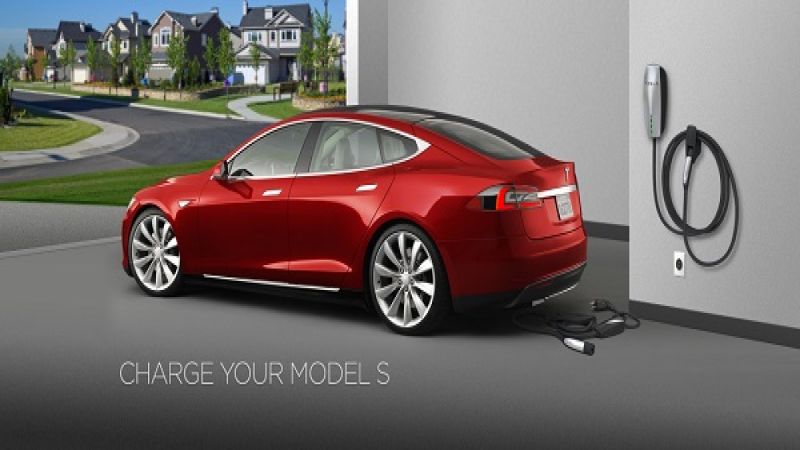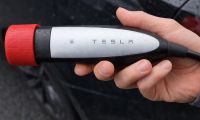A fire in Irvine California this past month highlights the fact that electric cars use more electricity than any other household appliance. The outlet in your garage was not intended to provide high amperage over a long period of time to charge a car. Like all appliances that draw a lot of current, any outlet that is used to charge an EV should be specifically designed and installed to accommodate that service.
EV Home Charger Wiring Basics
When an air conditioner or other large appliance is added to a home electricians do not tap into the existing wiring circuit closest to that appliance. Rather, they create what they call a “home run.” A home run is a circuit that goes from the single point of use directly back to the home’s main electrical panel. There are no other outlets on that wire. In addition, the circuit breaker that is between the appliance and the electrical supply (which is located in the electrical panel) will be added specifically for the service it will provide and it will be dedicated to just that one line.
A Tesla Model S can come with a battery pack as large as 85 kWh. That is pronounced 85 kilo Watt hours. This unit is a measure of power x time (energy). Take a look at your electrical bill. Mine says that I used a total of 644 kWh in all of November. That means that if I charged a Tesla from empty to full about 8 times, which would be twice per week, I would literally double my total electrical usage in the home. Charging 8 times would result in a range of about 2,000 miles per month. That is a lot of miles, but well within the amount of miles many Tesla owners report driving on forums we participate in. The upshot is that adding a powerful EV like a Tesla can double the amount of power your home’s electrical system handles. We are not trying to play any games here. If you feel the math has a logical error please reply below and we will re-check it.
On its website Tesla says “Most outlets are either standard 110 volt outlets or higher powered 240 volt outlets. Higher powered outlets charge between four and six times faster than standard household outlets. If you plan to install an outlet in your garage, we recommend a NEMA 14-50 240 volt outlet.” That is the type of heavy duty connection that an RV might use. It should be noted that the current rating on that is 50 amps (40 amps continuous draw). In your home there is nothing else that draws that much power. In fact, most New England homes built before the 1980s had only 60 amp service to the entire house. Now 100 amp or 200 amp is the norm. If your house has only 60 amp service you may need to change the entire electrical box. I did that on my home when I added a generator and AC system to my house. I paid about $1500 at the time, 15 years ago.
So far we have discussed the electrical service needs (not 60 amp), electrical panel needs (dedicated circuit breaker), and the wiring (home run to the point of use) for an EV. Tesla can help buyers with the proper in-car charging system (it offers both single and double) and also the type of home connector to use. Tesla also has a special High Power Wall Connector it can provide to owners who need fast, frequent charges. In its section on charging Tesla starts out noting that a “normal” 110 volt wall socket can only add 3 miles per hour of range to a Tesla Model S. Some quick math gives us a required charging time to add 240 miles of 80 hours! Clearly, that is not going to work for people who own these cars. It is just a nice option to have in emergency situations, or when one wishes to simply top off the battery on the road at a hotel.
Plan On an Electrician and Building Permit
If it has not yet become absolutely clear to the reader these electrical upgrades are not a homeowner project. In fact, they are not a handyman-service project either. Adding an EV charging point to a home should only be done by a licensed electrician who has pulled a building permit from the local town or municipality. Here in Massachusetts where I live, that would also result in the electrical building inspector visiting the jobsite after work is complete, inspecting the job to ensure it meets the code requirements for the town, and then the electrical inspector would sign the building permit if all was to his or her satisfaction. Anything less than this and your home-owner’s insurance policy is not required to cover problems like a garage fire that result from work done that was not to code. Here is what Tesla says about preparing your garage for your new Tesla:
“We recommend working with a trusted electrician to install your High Power Wall Connector or NEMA 14-50 outlet before your Model S arrives. All Model S include a Mobile Connector cable and an adapter for the NEMA 14-50 outlet. Depending on your home’s electrical system, installing a high Power Wall Connector at maximum amperage may be more difficult that installing a 240 volt outlet due to power availability. The High Power Wall Connector can be set to any amperage level. While you won’t charge at the rate of 58 miles per hour of charge, you will be able to enjoy the convenience of a sleek, permanently installed Connector.”
Home EV Charging Point Cost
The total cost to install a proper EV charging point in a home can start at about $750 for a home-run circuit and appropriate low current rating wall connector. The Tesla High Power Wall Connector requires a 100 amp circuit breaker to get the fastest charge rating. Most houses in New England cannot accommodate that. Adding 200 or 400 amp service, wiring the home run circuit and buying and installing the High Power Wall Connector could cost as much as $6,000.00. Our estimate is based on Tesla Forum discussions that say the electrical work including an upgrade to 200 or 400 amp service can range to as high as $3,000 and the Tesla website which lists the High Power Wall Charger and second on-board charger as a $2,700 adder to the car’s price tag. It should be noted that $6,000 will buy a lot of gas. In fact, it will buy 1,714 gallons of gasoline at today’s price of less than $3.50 per gallon. A 25 MPG car can travel about 43,000 miles on that amount of money. Again, we stress that these are the two bookends of the range one might pay.
The fire in Irvine California seems to have occurred at the connection between the Tesla’s cable and the wall. Here is what one news report summarized the Tesla response as being; "“The cable was fine on the vehicle side; the damage was on the wall side,” Tesla said of the garage fire. “Our inspection of the car and the battery made clear that neither were the source.”" We reached out to the Orange County Fire Authority for a comment and we asked if the job was recorded by a signed building permit, or their equivalent code requirements. They did not reply.
Evs are a part of the automotive present, not future. Those shopping for a new EV, particularly a Tesla, should include the cost to install the charger and make an installation plan including an electrician and building permit.













Comments
Typo: "recorded by a singed"
Permalink
Typo: "recorded by a singed" -> "recorded by a signed" although I think it would be clearer saying something more like "we asked if the job was covered by a signed building permit and met existing code".
Thanks for the comments
Permalink
In reply to Typo: "recorded by a singed" by Stephen Pace (not verified)
Thanks for the comments Stephen. I caught that typo shortly after publishing and it is fixed. More importantly, we see you are a "frequent flyer" now at Torque News and that makes us very happy! Thanks very much for reading and helping with the proof reading. Frankly, it is my biggest challenge and I will take all the help I can get.
Cheers,
Let's not forget that a Tesla
Permalink
Let's not forget that a Tesla S is a $70k MSRP car. Sales taxes are likely more than the cost of upgrading your electrical installation. If you are buying this car to "save" money on gas, clearly you need to rethink your approach.
This may be more meaningful for a full electric Ford Focus, which MSRP is half of that. Even there, the math is a stretch and you would need to drive a LOT to even out the initial investment cost.
Thanks David. I tend to
Permalink
In reply to Let's not forget that a Tesla by David Burg (not verified)
Thanks David. I tend to agree with you. I'm a geek and I like to run numbers. For me the EV payoff is not as apparent. - - One trend I do notice is that a lot of EV owners compare their new EV to their very old ICE car. When they run those numbers the EVs look pretty good. However, a Leaf compared to a 2014 Prius? Or in the case of a Tesla - compared to a Lexus GS hybrid? I come to a different financial conclusion than some EV owners seem to. - - However, I do respect the EV owners for stepping up for other reasons. Also, I can totally get owning a Tesla just because it is an amazing car.
"Charging 8 times would
Permalink
"Charging 8 times would result in a range of about 2,000 miles per month. That is a lot of miles, but well within the amount of miles many Tesla owners report driving on forums we participate in." -- This isn't fair. It's anecdotal at best. IIRC, the average American car drives about 1,000 miles per month. That SOME Tesla owners drive 2,000 mpm in no way suggests what the AVERAGE Tesla owner does. Of course, it is possible that those who drive a lot are attracted more to long-range electric vehicles like Model S. Although I do not expect to recapture the cost of that expensive car with fuel savings, some might.
On a typical day, I drive less than 50 miles. How about you? I can load 50 miles of range into my Model S from my NEMA 14-50 circuit in about two hours, usually from 12:00 - 2:00 AM. I hope Tesla updates its software to let owners specify when they want their charge to END rather than when it should BEGIN as it works today. It's what we call SMOP here in Silicon Valley - a Simple Matter of Programming. My car downloads an update every few months, also while I sleep. Maybe my pet feature will be next?!
Electricity costs vary wildly around the country, within a state and even around the clock. I have heard people quote costs as low as $0.07 per KWh. I was paying about $0.34 per KWh until I went on the EV rate. Now I charge my Tesla at night at about $0.10 per KWh. In one year, I have averaged 327 Wh per mile (11,000 miles, slightly below average) for a cost of about three cents per mile. I am pleased with this.
Like you sort of say, there is no fire danger from a properly installed, high current charging circuit. Yes, older homes may require more expensive retrofits in order to become EV-friendly. My 50+ year-old home in CA already had a 200A panel. The quoted cost to run the 14-50 circuit was $600 but IIRC it ended up about twice that because there was no more room in the panel and the electrician had to install a small sub-panel on the wall next to the main panel. The inspector signed it off and all is well.
Thanks Rick. I needed to use
Permalink
Thanks Rick. I needed to use some round numbers, but in fact we recently ran a story about a Leaf owner that drove 100,000 miles in one year. Under a different story we had a Tesla owner comment that he drives about the same. We also had a huge amount of commentary by EV owners saying that their Tesla is their primary, or only car and that they drive a lot. I drove about 23K this past year. My days alternate between local travel and about 130 miles to visit family a few times per week.
- - The most important thing I appreciate about your comment is that it says "Inspector signed off." I was not sure that was required in CA. If I was the homeowner who had the fire I would be very angry and I would find out why my home was almost destroyed. A part failure alone should not have allowed a fire.
---Also, there is a recent story here at TN where EV owners did write in and they claim their EV cost them next to nothing and they did do it for the money. Also, I have read similar comments from Tesla owners on forums who say by their math the Tesla is very affordable. My math is not so rosy, but I respect their move for other reasons.
- - Thanks again for taking time to write in.
Any tesla owner and in fact
Permalink
Any tesla owner and in fact any potential owner will see through this absurdly bias story, and in fact install safe and inexpensive charging systems. This is not even a smart try at knocking EVs.
Thank you for your opinion
Permalink
Thank you for your opinion Tony. Did I not mention that EV charging at home can start at $750 if one has a lot of time? If there is a cheaper setup detail it for us. You can find the cost adder for the wall charger on Tesla's webpage ($2,700). To get to the cost adder for a Tesla simply start the "Order" configurator. The charger mentioned in the story comes up as an adder just after you begin. Be sure you have selected "Cash" rather than finance. Or it will hide the cost of the adders and just show the lease price change. The wall mounted part alone is also sold separately by Tesla ($1200). Here is their webpage link:http://shop.teslamotors.com/collections/model-s-charging-adapters - Also, you can see the posts from which I took the numbers about home install costs on the Tesla official webpage blog. - You can also visit this website to read the fire report from OCFA. In the report you will see that the homeowner in fact did do the installation as I describe in the article. Here is that link: http://insideevs.com/tesla-mode-s-garage-fire-official-incident-report/ Electrical work is expensive. Poor electrical work can be even more costly.
Here is a cut and paste from
Permalink
Here is a cut and paste from the Tesla configurator. Sorry it loses its formatting:
High Power Home Charging
Outfit Model S with a second onboard charger and install the High Power Wall Connector in your garage. This combo lets owners charge quickly at home and ensures your Mobile Connector is always in the trunk for charging on the go. •Second onboard charger
•High power wall connector
Charge at up to 62 miles per hour (80 amps)
$2,700
Your article sheds light on
Permalink
Your article sheds light on the fact that an electric car is not a cheaper mode of transportation, simply an alternative one. If we take a look at the math indicated here, we find that the Tesla will cost no less than .15 cents per mile to fuel, based on your 2000 mile per month average. I'm from Southern Cal, and the PG&E rates are not cheep. Bottom Line: I'm not so damned sure that the Tesla has a lesser impact on the environment than an ecologically sound 40 mpg internal combustion driven auto.. After-all, the power plants in Southern California are Fuel or coal fired.
Please demonstrate otherwise...
Thanks Parks. It is nice to
Permalink
Thanks Parks. It is nice to know I am not the only one that sees that. I had no idea that CA used any coal plants (or fuel plants). I will say that I love Teslas./ However, when the crazy lease scheme came out I ran the numbers using the Tesla calculator and when I put in my electric rate there was no way the savings offset the high cost of the Tesla. I think the Model S stands solidly in the value category. It is so darn good it is clearly a competitor to an Audi RS 7 or similar car. However, I can't make the math work the way some owners can. Compared to other green choices like a Honda Accord Hybrid, Toyota Corolla LE Eco, or even just a Nissan Sentra, the Leaf and Volt make no sense (financially) to me at all.
Good point about getting a
Permalink
Good point about getting a licensed electrician and checked by electrical inspector. At least in my town, that is a legal requirement. But in terms of comparing costs, rather than theoretical, it might be good to see how one Model S owner's energy costs changed. In my case, my husband and I used to spend ~$200/month for gas. But since we drive more often in the Model S now, he spends less than $50/month on gas (he still has an ICE) and our electrical bill is up ~$50 more per month. But this is probably due to the fact that our electrical rate is $0.07/kwh since we get much of our electricity from hydroelectric and wind power.
Thanks Charlotte. How do you
Permalink
Thanks Charlotte. How do you charge at home? Would you mind sharing the cost with us of your installation and the type Tesla charger (on the car) you selected? - For those interested, Charlotte is the Tesla owner profiled on our Tesla page. We are proud to have her a frequent contributor.
http://www.torquenews.com/1083/surprising-look-who-buys-tesla-model-s
I did not get the High Power
Permalink
In reply to Thanks Charlotte. How do you by John Goreham
I did not get the High Power Wall Connector because my home electrical cannot support it, and I didn't think I would need it. I had a NEMA 14-50 installed at my home for less than $900. However, when the electrical inspector came to look, they found a major problem with electrical to the garage that was done before we purchased the home so that cost more, but I think that prevented any problems with heating or fires.
Yes, I think that is very
Permalink
Yes, I think that is very common. When an electrician works to install a new high power line like this they look closely to see if there are other issues. They don't want to be blamed for prior work that causes issues.
I don't know, you make it
Permalink
I don't know, you make it sound like it's rocket science.
I live in MA too. I researched exactly how to install this and made a detailed sketch which I submitted to the town with my electrical permit application. Once they gave me the permit, I did the work exactly following those plans. It took me about 8 hours; super easy except for burying 20' of conduit and setting the post(it's an outdoor installation). Set the dip switch and the little dial for 48A charging. Called the wiring inspector; he came over the next morning, inspected my work, approved it, and closed out the permit. Simple. Works perfectly.
I have a hard time understanding how you could do this wrong -- it's just two wires (plus a ground) and inserting a new breaker into your panel. I can't see paying someone hundreds of dollars to do this work; just get a permit and the wiring inspector will make 100% sure you've done things correctly.
You're joking right, Didier?
Permalink
In reply to I don't know, you make it by Didier Plante (not verified)
You're joking right, Didier? You can't see paying hundreds of dollars for the job you describe above?
Material costs - High amp breaker, 30 feet of wire, tools to cut that wire, wire nuts, materials to properly bury a wire (either plastic pipe or special wire plus the warning tape). Drill to cut the hole to exit the wall of the home. Caulking to caulk up said hole. Tools to dig a 20 foot trench in your yard. Seed and soil to cover the trench back up. What does that total?
Labor costs: Eight hours - Bill that at the rate a Tesla owner earns in their career.
Time Spent: Time to travel to the home center or multiple supply stores. Time spent to pull a permit. Time spent to design the layout you describe. Time spent researching the proper wire and design. Time spent to meet the electrical inspector for final. Time spent digging a trench running wire, connecting wires in a panel making connections, refilling trench etc.
Charger cost (the actual charger used).
That work is not worth "thousands of dollars?" I'd kill to have a handyman in my neighborhood like you.
John, of course you're right
Permalink
In reply to You're joking right, Didier? by John Goreham
John, of course you're right in general. But after a week of dealing with people, a lot of times it's fun to get up early on Saturday, get a coffee, drive over to Lowe's and do a project that doesn't involve being on the phone! Additionally, there were just too many trades that would have been involved here -- would have had to get someone to make the hollow post, some to set it over the end of the conduit and concrete it into place, someone to stain it, someone to do the electrics and someone to do the landscaping. Too many people and undoubtedly one would screw up or flake out entirely.
We just finished having our house renovated and the thought of having more contractors on-site is super unappealing. I don't like their music. I don't like that they make a mess of everything except their one trade. I don't like that they come in to use the bathroom. I don't like waiting around until they are done so I can pay them.
Additionally, I did talk to some electricians but gained no confidence that any really knew squat about EV chargers (turns out, per the wiring inspector, that mine is only the 2nd install in a town of 18,000!).
The other issue is, electricians HATE digging trenches! They act like it's incredibly difficult and are usually only willing do it with power equipment. (What drama queens!) Well, we have a lot of irrigation lines and underground downspout lines that aren't very deep, and the last thing you want is for some hamfisted guy to slice them. It wasn't the most pleasant task to make a trench but really no big deal.
Plus, I knew exactly how I wanted this. The post needed to be placed just so in order to look right, and to make that work, the conduit had to come up out of the ground in just the right place. I just figured it was easier to do myself than try to explain to some knucklehead(s). The wiring inspector said it came out every bit as good as he'd expect a pro to do it.
Your point is well taken though. 8 hours of time at any reasonable opportunity cost is a big number. I'm sure if I did that for someone else I would have charged (i) a fortune, plus (ii) a case of good wine.
Didler Plante,
Permalink
In reply to John, of course you're right by Didier Plante (not verified)
Didler Plante,
I've read both of your posts in response to Johns Article and his response to you. First props on getting out there and researching everything about doing your own electrical. Your ability to harness the magic of electricity, while being so casual about it really surprises me. See my take away from your two posts is this..
First, the way you articulate your message's indicate that you are what we in the skilled trades refer to as a "difficult client". When you the "Knuckleheads" you referred to came out to look at the job, you were probably oozing "RED FLAG warnings. So they didn't get back to you... It's as simple as that.
Your second issue is your dealing with "Post Construction Remodel Stress Disorder". As you shared you did a full remodel, you were forcefully introduced to new music, and you weren't happy about the mess of construction or that the used "your" bathroom instead of take the liberty of using the side of your house. I'm sure you spoke to your general contractor about all of these inconveniences that your were forced to be exposed to?
So with all of these post observations in mind Didler. I have a few questions that you John and the group may find interesting.
Since becoming a weekend expert:
1. How did you know that your homes electrical system would be able to withstand the additional 48 amp continuous demand on the service panel??
2. Do you know how to check European Lugs to ensure your conductors are correctly landed and won't eventually loosen themselves and burn up your charger? Why do I ask this question? I went on 8 service calls in two months for conductors that were incorrectly landed.
3. Was your charger in sight of your panel, and if not what kind of disconnect did you put in between?
I'm not knocking you for the research, putting the effort in to dig a ditch (BTW did you pull a dig permit?), or doing the work yourself (although your now in warranty violation if the charger gets damaged).
What I am sharing is that you don't paint a full picture in your comment to Johns article. You come across as a self proclaimed expert. This is dangerous message, because other "Graduates of YoutTube University and online DIY information" may not end up being as lucky with the outcome as you.
I do hope does work out for you, and I look forward to hearing your responses to my questions.
Hey Larry. I think it came
Permalink
In reply to Didler Plante, by Larry (not verified)
Hey Larry. I think it came out fine. It passed inspection and has charged the car successfully dozens of times.
As far as power requirements, we have 240/200amp service, which in theory would I guess be 48kW. We long ago installed one of those current monitors and even with everything turned on, the house uses less than a tenth of that. There were empty spaces in the panel so it wasn't that hard. Got the right fuse, wires, conduit, etc. etc. Just an issue of really taking time and care.
Not quite sure what you mean by European lugs, but perhaps you mean those rectangular crimps that go onto the end of the cables before connecting them to the charger. I was able to rent a crimping tool for those.
I did put the trench on the permit application. It took a few f-bombs to dig, but it was only 20 feet and not the end of the world using just a pick and a shovel. I did use a PVC conduit and the inspector verified that it was deep enough (in our town, you can't backfill a trench until they inspect what you've placed into it).
The wiring inspector did not call for a disconnect between the charger and the panel. It's about 25' but not line of sight. We specifically discussed that but apparently code did not require it in this particular instance. I thought it would require one of those disconnects like the solar array or the a/c condensors, but none was required in this case.
I guess things can always break, but the system has worked just fine for ~20 months. I'm sure a pro like you could do the installation in a tenth of the time it took me but unless I'm missing something it came out pretty much identically.
Hi Didler,
Permalink
In reply to Hey Larry. I think it came by Didier Plante (not verified)
Hi Didler,
Happy to hear you have a 200 A service and are using a home monitoring system. Regarding the disconnect, you can review Article 100 and Article 422.31 in the NEC. As my local inspectors will tell you, they are not the end all be all when it comes to Electrical and building. They are just making sure you are in compliance with your submitted plans for the permit.
If I could attach photos, I would share the European Lugs I referenced earlier. Not knowing whether you DIY installed a Gen I or Gen II Tesla wall connector leaves a couple questions that would be useful for this thread. If you had a Gen II there wouldn't have been a need to use ferrules or the crimping tool to connect the conductors inside the wall connector, because the unit is already set up to do that.
Regarding your 20 months of charging and no issues. You are one of the lucky ones. Lots of people have improperly landed the conductors in the lugs and then burned them up. (another series of photos I could share).
Bottom line: sounds like you did a good job because your DIY HPWC installation hasn't burned up and your permit was signed off. But, I would like to share some professional feedback from someone who does this for a living. You got lucky, and you have a lot of open holes in your DIY installation. This isn't because you didn't plan accordingly, spend more than a few hours on YouTube University, the Tesla Site and other online resources. It's because you don't know the equipment, electrical codes, or potential pitfalls associated with EV charging equipment. This is also the message others who read this thread should understand. I'm going to share a separate story to drive this point home. I've had many homeowners call me because they DIY rewired a 15 or 20 amp, 120Volt outlet. Afterwards the breaker in the panel kept tripping and they couldn't understand why. Everyone of them when I arrived said: It's an outlet..."t's not Rocket Science" or some other simplified metaphor. The Two Common issues I found in every case. Either they reversed the polarity or they took a switched outlet being fed on a two different 120V circuits and created a 240V circuit. Had either of these cases involved a Federal Pacific Stab Lock or Zinsco Panel, they very possibly would have been rebuilding a burned out section of the house versus asking me to solve something for them "They Claimed Wasn't Rocket Science". I certainly appreciate you providing me with the material to drive home the point that John shares in this article. Use a professional!! There is no place for DIY or Handy People when it comes to harnessing the magic of electricity..
Have a great weekend,
Larry
Hi Larry,
Permalink
In reply to Hi Didler, by Larry (not verified)
Hi Larry,
It's a Gen II. Question: What do you mean by a conductor that's "improperly landed"? Does that just mean connected shoddily? Clearly, moving this much current you need an absolutely solid, complete connection and not just one that's passing through a few strands of wire lest it overheat.
I don't know if I'm using the term "ferrule" correctly. The HPWC Gen II (mine is one of those black Elon Musk Signature Edition ones -- I'm not a fanboy, I just like the appearance of the black ones better) came with little rectangular fittings that get pressed onto the end of the conductors before they're inserted. It seems that those aren't absolutely necessary, but they do help to make and maintain a bombproof connection that can move a lot of current without the whole thing overheating.
I think you're actually right about the disconnect. That's really weird that the wiring inspector didn't call that out ... he is super super ultra picky. To your point, looking at the applicable part of the code, it says,
"For EVSE rated at more than 60 amps or more than 150 volts to ground, a means of disconnect must be installed in a readily accessible location and within sight of the electric charging connector."
Oh well. Too late for that now. There is obviously a dedicated fuse inside on the panel, but there's no disconnect outside.
John,
Permalink
John,
Great Article. You hit a lot of the pain points when it comes to adding an EV to your homes electrical service. I put together a guide for homeowners. Would you mind if I posted the link in the comments section?
Thanks,
Larry
Post it now and I will check
Permalink
In reply to John, by Larry F (not verified)
Post it now and I will check it out. I'm planning a bunch more on this topic soon. I could use the info myself. Thanks
Thanks John.
Permalink
In reply to Post it now and I will check by John Goreham
Thanks John.
Tried to post the link to my EV guide/calculation quiz for homeowners, but the site wouldn't allow me to upload it. DM me and I'll send you the link
Have a great day,
Larry